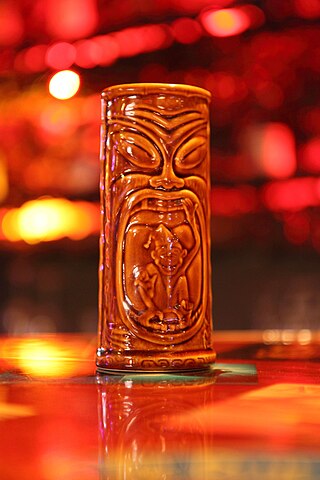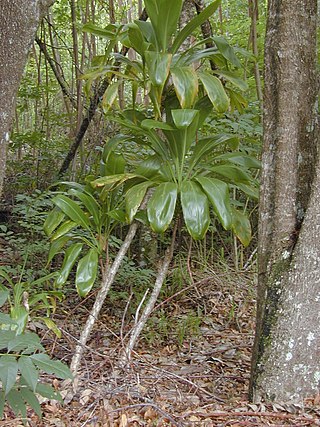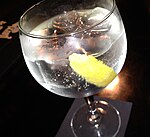
Tiki culture is an American-originated art, music, and entertainment movement inspired by Polynesian, Melanesian, and Micronesian cultures, and by Oceanian art. Influential cultures to Tiki culture include Australasia, Melanesia, Micronesia, Polynesia, the Caribbean Islands, and Hawaii. The name comes from Tiki, the Māori name for the first human, often represented in the form of hei-tiki, a pendant and important taonga. The hei-tiki was often appropriated by Europeans as a commercialised good luck charm, hence the name of Tiki culture. Despite spanning over 10,000 miles and including many different unrelated cultures, religions, and languages, Tiki aesthetic is considered by some to be amalgamated into one "fantasia of trans-Pacific cultures" and "colonial nostalgia". Because of this, and the simplistic view of the Pacific taken by the aesthetic, Tiki culture has often proved controversial.

The Mai Tai is a cocktail made of rum, Curaçao liqueur, orgeat syrup, and lime juice. It is one of the characteristic cocktails in Tiki culture.

The Zombie is a Tiki cocktail made of fruit juices, liqueurs, and various rums. It first appeared in late 1934, invented by Donn Beach at his Hollywood Don the Beachcomber restaurant. It was popularized on the East coast soon afterwards at the 1939 New York World's Fair.

The sidecar is a cocktail traditionally made with brandy, orange liqueur, and lemon juice. It became popular in Paris and London in the early 1920s. Common modifications of the original recipe are a sugar rim, added sugar syrup, and an orange twist or lemon twist.

Trader Vic's is a restaurant and tiki bar chain headquartered in Emeryville, California, United States. Victor Jules Bergeron, Jr. founded a chain of Polynesian-themed restaurants that bore his nickname, "Trader Vic". He was one of two people who claimed to have invented the Mai Tai. The other was his amicable competitor for many years, Donn Beach of the "Don the Beachcomber" restaurants.

ʻŌkolehao is a Hawaiian alcoholic spirit whose main ingredient was the root of the ti plant. 'Ōkolehao's forerunner was a fermented ti root beverage or beer. When distillation techniques were introduced by English seamen in 1790, it was distilled into a highly alcoholic spirit.

A tiki mug is a large ceramic cocktail drinking vessel that originated in tiki bars and tropical-themed restaurants. The term "tiki mug" is a blanket term for the sculptural drinkware even though they vary in size and most do not contain handles. They typically depict Polynesian, mock-Polynesian, tropical, nautical, or retro themes, and as the term is used generically do not always emulate a tiki. When used to serve drinks they are frequently garnished with fruit or decorative drink umbrellas and swizzle sticks.

A tiki bar is a themed drinking establishment that serves elaborate cocktails, especially rum-based mixed drinks such as the Mai Tai and Zombie cocktails. Tiki bars are aesthetically defined by their tiki culture décor which is based upon a romanticized conception of tropical cultures, most commonly Polynesian. Some bars also incorporate general nautical themes or retro elements from the early atomic age.
A Scorpion Bowl is a communally shared alcoholic tiki drink served in a large ceramic bowl traditionally decorated with wahine or hula-girl island scenes and meant to be drunk through long straws. Bowl shapes and decorations can vary considerably. Starting off as a single-serve drink known as the Scorpion cocktail, its immense popularity as a bowl drink in tiki culture is attributed to Trader Vic.

A "fizz" is a mixed drink variation on the older sours family of cocktail. Its defining features are an acidic juice and carbonated water. It typically includes gin or rum as its alcoholic ingredient.
Harry K. Yee was an American bartender from Honolulu, Hawaii, who was credited with having helped to spread tiki culture during the mid-twentieth century, both in Hawaii and in the continental United States. He invented the Blue Hawaii cocktail, and is attributed with being the first bartender to use paper parasols and vanda orchids in tiki drinks.
Harry MacElhone was an early 20th century bartender, famous for his bar in Paris, Harry's New York Bar; his influential cocktail book, Harry's ABC of Mixing Cocktails; and for inventing or first publishing numerous classic cocktails.

The doctor cocktail is a pre-prohibition era cocktail that traces in drink guides to as far back as 1917, when it appeared in Hugo R. Ensslin's Recipes for Mixed Drinks. As originally described the cocktail called simply for Swedish Punsch mixed with lime juice.
A Boomerang cocktail is a specific cocktail dating back to the early 20th century. In the 21st century, it may also be a reference to cocktails that bartenders illegally shuttle back and forth between bars as a way of sharing experimentation or building comradery.

The suffering bastard is the name for two different mixed drinks, one being more of a standard cocktail associated with World War II and the other being more of an exotic drink associated with Tiki bars. As is the case with many cocktails, there are multiple recipe variations and historical origins have been argued and changed over time. Two of the earliest recipe versions have very different ingredients. One from bartender Joe Scialom (1942) calls for brandy and gin, while another from Tiki pioneer Victor J. Bergeron primarily uses rum along with "secret ingredients" and is known for being garnished with a cucumber.
The Q.B. Cooler is a vintage tiki cocktail invented by Donn Beach that calls for a mixture of several rums, two syrups, fruit juices, and honey, mixed with club soda and dashes of Pernod, bitters, and grenadine. Another version purported to be from 1937 is slightly different and calls for varying rum proportions and ginger syrup in place of the fassionola and Pernod.
The cobra's fang is a vintage tiki cocktail invented by Donn Beach that calls for a mixture of rums along with fassionola and falernum syrups, the juice of orange and limes, and a dash each of bitters and grenadine. The recipe from the book Hawai'i: Tropical Rum Drinks & Cuisine By Don the Beachcomber calls for it being garnished with fresh mint and a lime wheel, although a length of spiral cut lime peel made to look like a snake is used for aesthetics in some cobra named cocktails.
The Fog Cutter is a vintage tiki cocktail frequently attributed to being invented by Victor Bergeron that calls for a mixture of several liquors, the juice of lemon and oranges, orgeat syrup, and cream sherry. It is high in alcoholic content and has been called the "Long Island Iced Tea of exotic drinks." It has historically been served in special Fog Cutter ceramic mugs.

Jeff "Beachbum" Berry is an American restaurant owner, author, and historian of tiki culture, particularly the drinks associated with the tiki theme. In addition to researching and reconstructing lost recipes, he has invented and published his own cocktail recipes.
The PB2Y, or PB2Y Gremlin, is a tiki drink created by Victor Bergeron as part of a series of "gremlin" drinks for his Trader Vic's restaurants during World War II.













